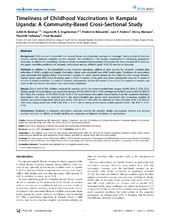| dc.description.abstract | Background: Child survival is dependent on several factors including high vaccination coverage. Timely receipt of vaccines ensures optimal immune response to the vaccines. Yet timeliness is not usually emphasized in estimating population immunity. In addition to examining timeliness of the recommended Expanded Programme for Immunisation (EPI) vaccines, this paper identifies predictors of untimely vaccination among children aged 10 to 23 months in Kampala. Methods: In addition to the household survey interview questions, additional data sources for variables included data collection of child's weight and length. Vaccination dates were obtained from child health cards. Timeliness of vaccinations were assessed with Kaplan–Meier time-to-event analysis for each vaccine based on the following time ranges (lowest–highest target age): BCG (birth–8 weeks), polio 0 (birth–4 weeks), three polio and three pentavalent vaccines (4 weeks–2 months; 8 weeks–4 months; 12 weeks–6 months) and measles vaccine (38 weeks–12 months). Cox regression analysis was used to identify factors associated with vaccination timeliness. Results: About half of 821 children received all vaccines within the recommended time ranges (45.6%; 95% CI 39.8–51.2). Timely receipt of vaccinations was lowest for measles (67.5%; 95% CI 60.5–73.8) and highest for BCG vaccine (92.7%: 95% CI 88.1–95.6). For measles, 10.7% (95% CI 6.8–16.4) of the vaccinations were administered earlier than the recommended time. Vaccinations that were not received within the recommended age ranges were associated with increasing number of children per woman (adjusted hazard ratio (AHR); 1.84, 95% CI 1.29–2.64), non-delivery at health facilities (AHR 1.58, 95% CI 1.02–2.46), being unmarried (AHR 1.49, 95% CI 1.15–1.94) or being in the lowest wealth quintile (AHR 1.38, 95% CI 1.11–1.72). Conclusions: Strategies to improve vaccination practices among the poorest, single, multiparous women and among mothers who do not deliver at health facilities are necessary to improve timeliness of vaccinations. | en_US |

